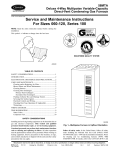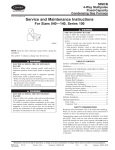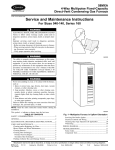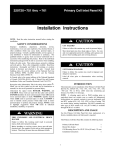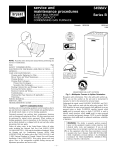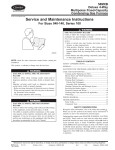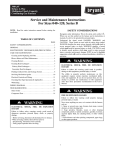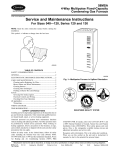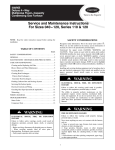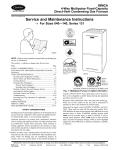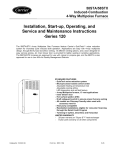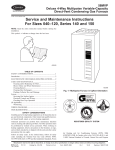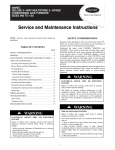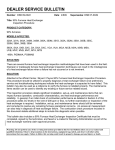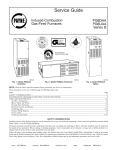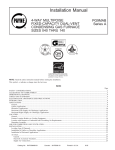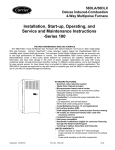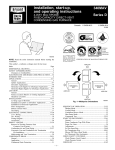Download Service Guide - HVACpartners
Transcript
Service Guide 4-Way Multipoise Fixed-Capacity Dual-Vent Condensing Gas Furnace PG9MAA Series E rr ier Cor pora ti on Ca EFFICIENCY RATING CERTIFIED ® I IR REG ST I SO M CERTIFIED E R E D F8 3 900 1 #A28 REGISTERED QUALITY SYSTEM A98187 Fig. 1—Multipoise Furnace in Upflow Orientation WARNING: ELECTRICAL SHOCK, FIRE, OR EXPLOSION HAZARD Failure to follow safety warnings exactly could result in dangerous operation, serious injury, death, or property damage. Improper servicing could result in dangerous operation, serious injury, death, or property damage. - Before servicing, disconnect all electrical power to furnace. - When servicing controls, label all wires prior to disconnecting. Reconnect wires correctly. - Verify proper operation after servicing. WARNING: The ability to properly perform maintenance on this equipment requires certain expertise, mechanical skills, tools, and equipment. If you do not possess these, do not attempt to perform any maintenance on this equipment other than those procedures recommended in the User’s Manual. FAILURE TO FOLLOW THIS WARNING COULD RESULT IN POSSIBLE DAMAGE TO THIS EQUIPMENT, SERIOUS PERSONAL INJURY, OR DEATH. WARNING: Never store anything on, near, or in contact with the furnace, such as: 1. Spray or aerosol cans, rags, brooms, dust mops, vacuum cleaners, or other cleaning tools. 2. Soap powders, bleaches, waxes or other cleaning compounds, plastic or plastic containers, gasoline, kerosene, cigarette lighter fluid, dry cleaning fluids, or other volatile fluids. 3. Paint thinners and other painting compounds, paper bags, or other paper products. Failure to follow this warning can cause corrosion of the heat exchanger, fire, personal injury, or death. Form: SG-PG9M-06 Cancels: SG-PG9M-05 Printed in U.S.A. 11-02 Catalog No. 53PG-9M21 NOTE: Read the entire instruction manual before starting the installation. INDEX Page SAFETY CONSIDERATIONS .....................................................................................................................................................................................2 GENERAL......................................................................................................................................................................................................................2 ELECTROSTATIC DISCHARGE (ESD) PRECAUTION..........................................................................................................................................2 CARE AND MAINTENANCE.....................................................................................................................................................................................3 Cleaning and/or Replacing Air Filter.......................................................................................................................................................................3 Blower Motor and Wheel Maintenance...................................................................................................................................................................4 Cleaning Burners ......................................................................................................................................................................................................5 Cleaning Heat Exchangers........................................................................................................................................................................................6 Primary Heat Exchangers....................................................................................................................................................................................6 Secondary Heat Exchangers................................................................................................................................................................................8 Flushing Collector Box and Drainage System ........................................................................................................................................................8 Servicing Hot Surface Igniter...................................................................................................................................................................................9 Electrical Controls and Wiring...............................................................................................................................................................................11 Checking Heat Tape Operation (If Applicable) ....................................................................................................................................................11 Winterizing..............................................................................................................................................................................................................12 WIRING DIAGRAM...................................................................................................................................................................................................13 SERVICE LABEL .......................................................................................................................................................................................................15 TROUBLESHOOTING GUIDE ............................................................................................................................................................................16-17 SAFETY CONSIDERATIONS Recognize safety information. This is the safety-alert symbol . When you see this symbol on the furnace and in instructions or manuals, be alert to the potential for personal injury. Understand the signal words DANGER, WARNING, CAUTION, and NOTE. These words are used with the safety-alert symbol. DANGER identifies the most serious hazards which will result in severe personal injury or death. WARNING signifies hazards which could result in personal injury or death. CAUTION is used to identify unsafe practices which would result in minor personal injury or product and property damage. NOTE is used to highlight suggestions which will result in enhanced installation, reliability, or operation. Installing and servicing heating equipment can be hazardous due to gas and electrical components. Only trained and qualified service agency personnel should install, repair, or service heating equipment. Untrained personnel can perform basic maintenance functions described in User’s Information Manual such as cleaning and replacing air filters. All other operations must be performed by trained and qualified service agency personnel. When working on heating equipment, observe precautions in the literature, on tags, and on labels attached to or shipped with the unit and other safety precautions that may apply. → Follow all safety codes including the National Fuel Gas Code (NFGC) NFPA 54-2002/ANSI Z223.1-2002 in the USA; National Standard of Canada, Natural Gas and Propane Installation Code CSA B149.1-00 (NSCNGPIC) in Canada; and the Installation Standards, Warm Air Heating and Air Conditioning Systems (NFPA 90B) ANSI/NFPA 90B. Wear safety glasses and work gloves. Have a fire extinguisher available during start-up and adjustment procedures and service calls. CAUTION: Label all wires prior to disconnection when servicing controls. Wiring errors can cause improper and dangerous operation. GENERAL These instructions are written as if the furnace is installed in an upflow application. An upflow furnace application is where the blower is located below the combustion and controls section of the furnace, and conditioned air is discharged upward. Since this furnace can be installed in any of the 4 positions shown in Fig. 2, you may need to revise your orientation to component location accordingly. ELECTROSTATIC DISCHARGE (ESD) PRECAUTIONS CAUTION: Electrostatic discharge can affect electronic components. Take precautions during furnace installation and servicing to protect the furnace electronic control. Precautions will prevent electrostatic discharges from personnel and hand tools which are held during the procedure. These precautions will help to avoid exposing the control to electrostatic discharge by putting the furnace, the control, and the person at the same electrostatic potential. 1. Disconnect all power to the furnace. DO NOT TOUCH THE CONTROL OR ANY WIRE CONNECTED TO THE CONTROL PRIOR TO DISCHARGING YOUR BODY’S ELECTROSTATIC CHARGE TO GROUND. 2. Firmly touch a clean, unpainted, metal surface of the furnace chassis which is close to the control. Tools held in a person’s hand during grounding will be satisfactorily discharged. 3. After touching the chassis you may proceed to service the control or connecting wires as long as you do nothing that recharges your body with static electricity (for example; DO NOT move or shuffle your feet, DO NOT touch ungrounded objects, etc.). 4. If you touch ungrounded objects (recharge your body with static electricity), firmly touch furnace again before touching control or wires. 5. Use this procedure for installed and uninstalled (ungrounded) furnaces. 6. Before removing a new control from its container, discharge your body’s electrostatic charge to ground to protect the control from damage. If the control is to be installed in a furnace, follow items 1 through 5 before bringing the control or yourself into contact with the furnace. Put all used AND new controls into containers before touching ungrounded objects. —2— AIRFLOW UPFLOW HORIZONTAL RIGHT HORIZONTAL LEFT DOWNFLOW AIRFLOW AIRFLOW AIRFLOW A93041 Fig. 2—Multipoise Orientations 7. An ESD service kit (available from commercial sources) may also be used to prevent ESD damage. CARE AND MAINTENANCE For continuing high performance and to minimize possible equipment failure, it is essential that maintenance be performed annually on this equipment. Consult your local dealer about proper maintenance and maintenance contract availability. WARNING: Turn off the gas and electrical supplies to the unit before performing any maintenance or service. Follow the operating instructions on the label attached to the furnace. Failure to follow this warning could result in personal injury or death. The minimum maintenance that should be performed on this equipment is as follows: 1. Check and clean or replace air filter each month as needed. 2. Check blower motor and wheel for cleanliness annually. 3. Check electrical connections for tightness and controls for proper operation each heating season. Service as necessary. 4. Check for proper condensate drainage. Clean as necessary. 5. Check for blockages in combustion-air and vent pipes annually. 6. Check burners for cleanliness annually. → CAUTION: Be careful of sharp metal edges, etc. Use care and wear protective clothing safety glasses, and gloves when removing parts. Failure to follow this caution could result in personal injury. PROCEDURE 1—CLEANING AND/OR REPLACING AIR FILTER The air filter arrangement may vary depending on the application or orientation. WARNING: Never operate unit without a filter or with the blower access panel removed. Failure to follow this warning could result in a fire or personal injury. CAUTION: Operating a unit without a filter or with the blower access door removed could cause damage to the furnace blower motor. Dust and lint on internal parts of furnace can cause a loss of efficiency. NOTE: If filter has cross-mesh binding, binding must face blower. If filter has an air direction arrow, arrow must point toward blower. To clean or replace the filters, proceed as follows: 1. Turn off electrical supply to furnace. 2. Remove main furnace door and blower access panel. 3. Release filter retainer wire. (See Fig. 3 or 4.) 4. Slide filter out of furnace. 5. Furnaces are equipped with permanent, washable filter(s). Clean filter by spraying cold tap water through filter in opposite direction of airflow. 6. Rinse filter and let dry. Oiling or coating of filter is not recommended. —3— WASHABLE FILTER FILTER RETAINER WASHABLE FILTER FILTER SUPPORT FILTER RETAINER A93046 A93045 Fig. 3—Bottom Filter Arrangement Fig. 4—Filter Installed for Side Inlet 7. Slide filter into furnace. 8. Recapture filter retainer wire. 9. Replace blower access panel and main furnace door. 10. Turn on electrical supply to furnace. PROCEDURE 2—BLOWER MOTOR AND WHEEL MAINTENANCE To ensure long life, economy, and high efficiency, clean accumulated dirt and grease from blower wheel and motor annually. The inducer and blower motors are pre-lubricated and require no additional lubrication. These motors can be identified by the absence of oil ports on each end of the motor. The following items should be performed by a qualified service technician. Clean blower motor and wheel as follows: 1. Turn off electrical supply to furnace. 2. Remove main furnace door and blower access panel. 3. Disconnect blower motor wires from furnace control board. Field thermostat connections may need to be disconnected depending on their length and routing. 4. Remove control box mounting screws, and position control box, transformer, and door switch assembly to right side of furnace casing. 5. If condensate trap is located in left- or right-hand side of furnace casing, proceed to item 6, otherwise remove trap and tubing as described below. (See top left of Fig. 8.) a. Disconnect field drain connection from condensate trap. b. Disconnect drain and relief port tubes from condensate trap. c. Remove condensate trap from blower shelf. 6. Remove screws securing blower assembly to blower shelf and slide blower assembly out of furnace. 7. Clean blower wheel and motor by using a vacuum with soft brush attachment. Be careful not to disturb balance weights (clips) on blower wheel vanes. Do not bend wheel or blades as balance will be affected. 8. If greasy residue is present on blower wheel, remove wheel from the blower housing and wash it with an appropriate degreaser. To remove wheel: a. Mark blower wheel location on shaft before disassembly to ensure proper reassembly. b. Loosen setscrew holding blower wheel on motor shaft. NOTE: Mark blower mounting arms and blower housing so each arm is positioned at the same hole location during reassembly. c. Mark blower wheel orientation and cutoff plate location to ensure proper reassembly. d. Remove screws securing cutoff plate and remove cutoff plate from housing. e. Remove bolts holding motor mounts to blower housing and slide motor and mounts out of housing. Disconnect capacitor and ground wire attached to blower housing before removing motor. Motor mounts need not be removed from motor. f. Remove blower wheel from housing. CAUTION: The blower wheel should not be dropped or bent as balance will be affected. g. Clean wheel per instructions on degreaser cleaner. Do not get degreaser cleaner in motor. —4— 9. Reassemble motor and blower wheel by reversing items 8b through 8f. Ensure wheel is positioned for proper rotation. Be sure to reattach ground wire. Tighten setscrew to 140 to 160 in.-lb torque. 10. Reinstall blower assembly in furnace. 11. Reinstall control box, transformer, and door switch assembly on blower shelf. 12. Reinstall condensate trap and tubing if previously removed. a. Reinstall condensate trap in hole in blower shelf. b. Connect condensate trap drain tubes. See Fig. 8 or tubing diagram on main furnace door for proper tube location. NOTE: Ensure tubes are not kinked or pinched, as this will affect operation. (1.) Connect 1 tube (blue or blue and white striped) from collector box. (2.) Connect 1 tube (violet or unmarked) from inducer housing. (3.) Connect 1 tube (relief port, green or pink) from collector box. c. Connect field drain to condensate trap. 13. Reconnect wires. Refer to furnace wiring diagram, and connect thermostat leads if previously disconnected. (See Fig. 16.) NOTE: Refer to Table 1 for motor speed lead reconnection if leads were not identified before disconnection. CAUTION: Heating speed selection MUST be adjusted to provide proper temperature rise as specified on the rating plate. Failure to adjust the heating speed may shorten heat exchanger life. Table 1—Speed Selector COLOR Black Yellow (When Present) Blue Red White SPEED High Medium High Medium Low Low Common FACTORY ATTACHED TO Cool Spare Heat Spare Com 14. Turn on electrical supply. Manually close blower access door switch. Use a piece of tape to hold switch closed. Check for proper rotation and speed changes by performing a component self-test as shown at the bottom of SERVICE label. (See Fig. 17.) WARNING: Blower access door switch opens 115-v power to furnace control. No component operation can occur. Caution must be taken when manually closing this switch for service purposes. Failure to follow this warning could result in electrical shock, personal injury, or death. 15. If furnace is operating properly, remove tape to release blower access door switch, replace blower access door, and replace main furnace door. PROCEDURE 3—CLEANING BURNERS The following items should be performed by a qualified service technician. If burners develop an accumulation of light dirt or dust, they may be cleaned by using the following procedure: 1. Turn off gas and electrical supplies to furnace. 2. Remove main furnace door. 3. Remove burner box cover. 4. Using backup wrench, disconnect gas supply pipe from furnace gas control valve. CAUTION: Label all wires prior to disconnection when servicing controls. Wiring errors can cause improper and dangerous operation. 5. Remove wires from gas valve. Note location for reassembly. 6. Remove burner box pressure tube from gas valve regulator fitting. 7. Remove screws that secure manifold to burner box. (See Fig. 5.) NOTE: Do not remove burner box from cell panel. 8. Remove manifold, orifices, and gas valve as 1 assembly. 9. Remove screws attaching burner assembly in burner box. 10. Remove burner assembly from burner box. —5— CELL PANEL MANIFOLD MOUNTING SCREW MANIFOLD GAS VALVE REGULATOR FITTING GAS VALVE Fig. 5—Burner Box Assembly A96304 NOTE: All burners are attached to burner bracket and can be removed as 1 assembly. 11. Clean burners with soft brush and vacuum. 12. Reinstall manifold, orifice, and gas valve assembly in burner box. Ensure manifold seal grommet is installed properly and burners fit over orifices. 13. Reconnect wires to gas valve. Refer to furnace wiring diagram for proper wire location. 14. Reinstall burner box pressure tube to gas valve regulator fitting. 15. Reinstall gas supply pipe to furnace gas control valve using backup wrench on gas valve to prevent rotation and improper orientation. NOTE: Use propane gas resistant pipe dope to prevent gas leaks. DO NOT use Teflon tape. WARNING: Gas valve switch MUST be facing forward or tilted upward. Failure to follow this warning could result in property damage, personal injury, or death. 16. Replace burner box cover. 17. Turn on gas and electrical supplies to furnace. WARNING: FIRE OR EXPLOSION HAZARD Failure to follow the safety warnings exactly could result in serious injury, death, or property damage. Never test for gas leaks with an open flame. Use a commercially available soap solution made specifically for the detection of leaks to check all connections. A fire or explosion may result causing property damage, personal injury, or loss of life. 18. Check for gas leaks. 19. Replace main furnace door. PROCEDURE 4—CLEANING HEAT EXCHANGERS The following items should be performed by a qualified service technician. A. Primary Heat Exchangers If heat exchangers get an accumulation of light dirt or dust on the inside, they may be cleaned by the following procedure: NOTE: If heat exchangers get a heavy accumulation of soot and carbon, both the primary and secondary heat exchangers should be replaced rather than trying to clean them thoroughly due to their intricate design. A build-up of soot and carbon indicates that a problem exists which needs to be corrected, such as improper adjustment of manifold pressure, insufficient or poor quality combustion air, improper vent termination, incorrect size or damaged manifold orifice(s), improper gas, or a restricted heat exchanger (primary or secondary). Action must be taken to correct the problem. 1. Turn off gas and electrical supplies to furnace. 2. Remove main furnace door. CAUTION: Label all wires prior to disconnection when servicing controls. Wiring errors can cause improper and dangerous operation. 3. Disconnect wires or connectors to flame rollout switch, gas valve, igniter, and flame sensor. —6— PRIMARY HX INLET OPENINGS RTV PAM A96305 Fig. 6—Cleaning Inlet Openings of Primary Heat Exchangers A93087 Fig. 7—Combustion-Air Intake Housing Gasket Repair TUBE ROUTING Furnace is shipped from factory in upflow configuration. Pressure tube and drain tube routing MUST match the diagrams below. BURNER ENCLOSURE PRESSURE REFERENCE TUBE ASSEMBLY (Blower access panel removed) CAP CAP COLLECTOR BOX TUBE (PINK) PLUG COLLECTOR BOX TUBE (GREEN) COLLECTOR BOX DRAIN TUBE (BLUE & WHITE STRIPED) INDUCER HOUSING (MOLDED) DRAIN TUBE (BEHIND COLLECTOR BOX DRAIN TUBE) CONDENSATE TRAP COLLECTOR BOX DRAIN TUBE (BLUE) COLLECTOR BOX TUBE (GREEN) CONDENSATE TRAP INDUCER HOUSING DRAIN TUBE (VIOLET) Condensate Trap on RIGHT Side Tube location when used in DOWNFLOW application PLUG COLLECTOR BOX DRAIN TUBE (BLUE) PLUGGED END CAP CAP COLLECTOR BOX TUBE (PINK) PLUG COLLECTOR BOX DRAIN TUBE (BLUE & WHITE STRIPED) COLLECTOR BOX TUBE (GREEN) INDUCER HOUSING DRAIN TUBE (VIOLET) COLLECTOR BOX EXTENSION TUBE COLLECTOR BOX EXTENSION TUBE CONDENSATE TRAP COLLECTOR BOX TUBE (PINK) BURNER ENCLOSURE PRESSURE REFERENCE TUBE ASSEMBLY COLLECTOR BOX EXTENSION TUBE BURNER ENCLOSURE PRESSURE REFERENCE TUBE ASSEMBLY DRAIN TUBE COUPLING DRAIN TUBES ROUTED IN FRONT OF GAS VALVE INDUCER HOUSING DRAIN TUBE (VIOLET) Tube location when used on HORIZONTAL - LEFT application COLLECTOR BOX DRAIN TUBE (BLUE & WHITE STRIPED) CAP COLLECTOR BOX TUBE (GREEN) BURNER ENCLOSURE PRESSURE REFERENCE TUBE ASSEMBLY INDUCER HOUSING DRAIN TUBE (VIOLET) COLLECTOR BOX EXTENSION TUBE COLLECTOR BOX DRAIN TUBE (BLUE) CONDENSATE TRAP DRAIN TUBE COUPLING CONDENSATE TRAP GAS VALVE COLLECTOR BOX EXTENSION DRAIN TUBE Tube location when used on HORIZONTAL - RIGHT application COLLECTOR BOX DRAIN TUBE (BLUE) PLUG COLLECTOR BOX EXTENSION DRAIN TUBE COLLECTOR BOX DRAIN TUBE (BLUE) COLLECTOR BOX DRAIN TUBE (BLUE & WHITE STRIPED) COLLECTOR BOX TUBE (GREEN) NOTE: COLLECTOR BOX DRAIN TUBE (BLUE & WHITE STRIPED) COLLECTOR BOX DRAIN TUBE (BLUE) FIELD-INSTALLED FACTORY-SUPPLIED 1/2-IN. CPVC STREET ELBOWS (2) FOR LEFT DRAIN OPTION FIELD-INSTALLED FACTORY-SUPPLIED DRAIN TUBE BURNER ENCLOSURE PRESSURE REFERENCE TUBE ASSEMBLY PLUG COLLECTOR BOX TUBE (PINK) FIELD-INSTALLED FACTORY-SUPPLIED DRAIN TUBE COUPLING (RIGHT DRAIN OPTION) FIELD-INSTALLED FACTORY-SUPPLIED DRAIN TUBE COUPLING (LEFT DRAIN OPTION) Condensate Trap on LEFT Side Condensate Trap on LEFT Side Optional Tube location when used in UPFLOW application Condensate Trap; Factory Installed in Blower Shelf COLLECTOR BOX TUBE (PINK) RELOCATE TUBE BETWEEN BLOWER SHELF AND INDUCER HOUSING FOR 040,060, AND 080 HEATING INPUT FURNACES COLLECTOR BOX EXTENSION TUBE COLLECTOR BOX TUBE (PINK) AUXILIARY "J" BOX RELOCATED HERE PLUG CAP BURNER ENCLOSURE PRESSURE REFERENCE TUBE ASSEMBLY COLLECTOR BOX EXTENSION TUBE COLLECTOR BOX TUBE (GREEN) COLLECTOR BOX DRAIN TUBE (BLUE AND WHITE STRIPED) CONDENSATE TRAP INDUCER HOUSING DRAIN TUBE (VIOLET) 1. All tubing must be connected securely and routed to avoid kinks and traps. 2. Pressure tubing must always slope away from pressure switch to collector box connection as shown. 3. HORIZONTAL-LEFT installations require the collector box pressure tube to be relocated between the inducer housing and the blower shelf to prevent a trap. Refer to the Installation Instructions for further details. 324999-201 REV. C A00308 Fig. 8—Furnace Pressure and Drain Tubing Diagram —7— 4. Disconnect combustion-air intake pipe from intake housing. 5. Remove pressure switch tube from intake housing. 6. Remove screws attaching intake housing to burner box, and rotate intake housing away from burner box for removal. 7. Using backup wrench, disconnect gas supply pipe from gas valve. 8. Disconnect pressure tubing from gas valve. 9. Remove 2 screws attaching top filler panel and rotate upwards to gain access to screws attaching burner box to cell panel. 10. Remove screws attaching burner box to cell panel. (See Fig. 5.) NOTE: Burner box cover, manifold, gas valve, and burner assembly should be removed as 1 assembly. 11. Clean heat exchanger openings with a vacuum and a soft brush. (See Fig. 6.) NOTE: After cleaning, inspect heat exchangers to ensure they are free of all foreign objects that may restrict flow of combustion products. 12. Reverse items 4 through 10 for reassembly. CAUTION: The ground wire from the gas valve MUST be attached to the burner box attachment screw. Failure to attach this ground wire to an adequate casing ground will cause the furnace control to lock out. NOTE: Be sure burner box gasket is installed between burner box and cell panel. See Fig. 5. If gasket is damaged, replace it. NOTE: Inspect combustion-air intake housing. If foamed gasket was removed, check for any damage. If gasket is damaged in any way, it must be repaired. To repair, remove damaged gasket section, apply sealant releasing agent such as PAM cooking spray or equivalent (must not contain corn or canola oil, aromatic or halogenated hydrocarbons, which could cause an inadequate seal to occur) to burner box and apply a small bead of G.E. RTV 162, G.E. RTV 6702, or Dow-Corning RTV 738 sealant to edge of combustion-air intake housing. (See Fig. 7.) 13. Refer to furnace wiring diagram and connect wires to flame rollout switch, gas valve, igniter, and flame sensor. 14. Reconnect pressure switch tubes to gas valve and intake housing. Refer to tube routing label on main furnace door for proper tube location. Be sure tubes are not kinked. (See Fig. 8.) 15. Turn on gas and electrical supplies to furnace. 16. Check furnace operation through 2 complete heat operating cycles. Look through sight glass in burner enclosure to check burners. Burner flames should be clear blue, almost transparent. (See Fig. 9.) WARNING: FIRE OR EXPLOSION HAZARD Failure to follow the safety warnings exactly could result in serious injury, death, or property damage. Never test for gas leaks with an open flame. Use a commercially available soap solution made specifically for the detection of leaks to check all connections. A fire or explosion may result causing property damage, personal injury, or loss of life. 17. Check for gas leaks. 18. Replace main furnace door. B. Secondary Heat Exchangers NOTE: The condensing side (inside) of secondary heat exchangers CANNOT be serviced or inspected. A small number of bottom outlet openings can be inspected by removing inducer assembly. See Flushing Collector Box and Drainage System section for details on removing inducer assembly. PROCEDURE 5—FLUSHING COLLECTOR BOX AND DRAINAGE SYSTEM 1. Turn off gas and electrical supplies to furnace. 2. Remove main furnace door. 3. Disconnect inducer motor and pressure switch wires or connectors. 4. Disconnect pressure switch tubes. 5. Disconnect vent pipe from inducer housing outlet by loosening clamp. 6. Disconnect drain tube from inducer housing. (See Fig. 8.) 7. Remove inducer housing assembly by removing 4 bolts attaching assembly to cell panel. 8. Flush inside of collector box with water until discharge from condensate trap is clean and runs freely. NOTE: Ensure that drain tube disconnected from inducer housing is higher than collector box opening or water will flow out tube. 9. Inspect inside area of collector box for any pieces of foreign materials and remove if present. CAUTION: DO NOT use wire brush or other sharp object to inspect or dislodge materials in secondary heat exchangers as failure of the secondary heat exchanger will occur. Flush with water only. → 10. Reassemble inducer assembly by reversing items 5 through 7. Tighten the vent coupling screw(s) to 15 in.-lb. of torque. —8— ;; ;; PAM BURNER FLAME RTV BURNER MANIFOLD A89020 A93081 Fig. 9—Burner Flame Fig. 10—Gasket on Collector Box NOTE: If seal between inducer housing and collector box is damaged in any way, it must be repaired. To repair, apply sealant releasing agent such as PAM cooking spray or equivalent (must not contain corn or canola oil, aromatic or halogenated hydrocarbons, which could cause an inadequate seal to occur) to inducer housing. (See Fig. 10.) Apply a small bead of G.E. RTV 162, G.E. RTV 6702, or Dow-Corning RTV 738 sealant to groove in collector box. 11. Refer to furnace wiring diagram and connect wires to inducer motor and pressure switch or connectors. 12. Reconnect pressure tubes to pressure switch. See diagram on main furnace door for proper location of tubes. Be sure tubes are not kinked. (See Fig. 8.) 13. Turn on gas and electrical supplies to furnace. 14. Check furnace operation through 2 complete heat operating cycles. Check area below inducer housing, vent pipe, and condensate trap to ensure no condensate leaks occur. If leaks are found, correct problem. WARNING: FIRE OR EXPLOSION HAZARD Failure to follow the safety warnings exactly could result in serious injury, death, or property damage. Never test for gas leaks with an open flame. Use a commercially available soap solution made specifically for the detection of leaks to check all connections. A fire or explosion may result causing property damage, personal injury, or loss of life. 15. Check for gas leaks. 16. Replace main furnace door. PROCEDURE 6—SERVICING HOT SURFACE IGNITER The igniter does NOT require annual inspection. Check igniter resistance before removal. 1. Turn off gas and electrical supplies to furnace. 2. Remove main furnace door. 3. Disconnect igniter wire connection. 4. Check igniter resistance. a. Using an ohm meter, check resistance across both igniter leads in connector. b. Cold reading should be between 45 ohms and 90 ohms. c. If ohm reading is higher than 110 ohms, igniter is cracked and must be replaced. 5. Remove igniter. CAUTION: Allow igniter to cool before removal. Normal operating temperatures exceed 2000°F. a. Do not remove igniter from bracket while assembly is in furnace. Using a 1/4 in. nutdriver, remove screw securing bracket and igniter assembly to bottom of burner box. The screw in the bracket is always located toward outside of burner box. The screw may be hidden by inlet box or inlet pipe, but can be removed without removing either. After removing screw, slide igniter and bracket toward outside of burner box and pull straight out. —9— FIELD 24-V WIRING FIELD 115-, 208/230-, 460-V WIRING FACTORY 24-V WIRING FACTORY 115-V WIRING NOTE 2 W FIVE WIRE THREE-WIRE HEATING-ONLY C R G Y THERMOSTAT TERMINALS FIELD-SUPPLIED DISCONNECT 208/230- OR 460-V THREE PHASE BLOWER DOOR SWITCH BLK W BLK WHT C O N T R O L WHT GND GND 115-V FIELDSUPPLIED DISCONNECT AUXILIARY J-BOX R 208/230-V SINGLE PHASE G COM GND NOTE 1 CONDENSING UNIT Y TWO WIRE 24-V TERMINAL BLOCK FURNACE NOTES: 1. Connect Y-terminal in furnace as shown for proper blower operation. 2. Some thermostats require a "C" terminal connection as shown. 3. If any of the original wire, as supplied, must be replaced, use same type or equivalent wire. A02174 Fig. 11—Field Wiring TWINNING AND/OR COMPONENT TEST TERMINAL BLOWER OFF-DELAY J2 JUMPER BLOWER OFF-DELAY 120 180 90 150 J2 HUMIDIFIER TERMINAL (24-VAC 0.5 AMP MAX.) G Com 24V 24-V THERMOSTAT TERMINALS W TRANSFORMER 24-VAC CONNECTIONS PLT Y TEST/TWIN R HUM 0.5 AMP@24VAC NUETRAL BLW STATUS CODE LED 3-AMP FUSE FUSE 3-AMP L2 PL1-LOW VOLTAGE MAIN HARNESS CONNECTOR 1 115-VAC(L2)NEUTRAL CONNECTIONS EAC-2 PLT LED OPERATION & DIAGNOSTIC LIGHT SEC-2 SEC-1 COOL HEAT COOL HEAT 1-AMP@ EAC-1 115VAC PR-1 L1 SPARE-1 SPARE-2 PL2 1 SPARE-1 BLOWER SPEED SELECTION TERMINALS SPARE-2 115 VAC (L1) LINE VOLTAGE CONNECTION PL2-HOT SURFACE IGNITER & INDUCER MOTOR CONNECTOR EAC-1 TERMINAL (115-VAC 1.0 AMP MAX.) A02100 Fig. 12—Control Center —10— CAUTION: The igniter is fragile. DO NOT allow it to hit the side of the burner box opening while removing or replacing it. b. Inspect igniter for a white area indicating a crack may be present. If found, replace igniter. NOTE: A small crack cannot be seen on a new igniter. After a period of operation, a white area will be visible around the crack. c. If replacement is required, replace igniter on igniter bracket external to furnace to avoid damage as the silicon portion is very brittle and will easily crack or shatter. d. To remove igniter from igniter bracket, remove screw holding igniter ceramic block to bracket and pull ceramic block out of bracket. 6. To replace igniter/igniter assembly, reverse items 5a through 5d. 7. Reconnect igniter wire connection. 8. Turn on gas and electrical supplies to furnace. 9. Verify igniter operation by initiating furnace control self-test feature or by cycling thermostat. 10. Replace main furnace door. PROCEDURE 7—ELECTRICAL CONTROLS AND WIRING CAUTION: There may be more than 1 electrical supply to the furnace. Check accessories and cooling unit for additional electrical supplies. The electrical ground and polarity for 115-v wiring must be maintained properly. Refer to Fig. 11 for field wiring information and to Fig. 16 for furnace wiring information. NOTE: If polarity is not correct, STATUS LED on furnace control board will flash rapidly and prevent furnace from operating. The control system also requires an earth ground for proper operation of furnace control and flame sensor. The 24-v circuit contains an automotive-type, 3-amp fuse located on the control. (See Fig. 12.) Any direct shorts of the 24-v wiring during installation, service, or maintenance will cause this fuse to blow. If fuse replacement is required, use ONLY a 3-amp fuse of identical size. The control LED will flash status code 24 when fuse needs to be replaced. With power to unit disconnected, check all electrical connections for tightness. Tighten all screws on electrical connections. If any smoky or burned connections are found, disassemble connection, clean all parts, strip wire, and reassemble properly and securely. Reconnect electrical supply to unit and observe unit through 1 complete operating cycle for proper operation. PROCEDURE 8—CHECKING HEAT TAPE OPERATION (IF APPLICABLE) In applications where the ambient temperature around the furnace is 32°F or lower, freeze protection measures are required. If heat tape has been applied, check to ensure it will operate when low temperatures are present. CAUTION: If this furnace is to be operated in an unconditioned space where the ambient temperatures may be 32°F or lower, freeze protection measures must be taken. (See Fig. 13.) See CONDENSATE DRAIN PROTECTION section of Installation, Start-Up and Operating Instructions. NOTE: Heat tape, when used, should be wrapped around the condensate drain trap and drain line. There is no need to use heat tape within the furnace casing. Most heat tapes are temperature activated, and it is not practical to verify the actual heating of the tape. Check the following: 32°F MINIMUM INSTALLED AMBIENT OR FREEZE PROTECTION REQUIRED Fig. 13−Winterizing the Furnace —11— A93058 1. Check for signs of physical damage to heat tape such as nicks, cuts, abrasions, gnawing by animals, etc. 2. Check for discolored heat tape insulation. If any damage or discolored insulation is evident, replace heat tape. 3. Check that heat tape power supply circuit is on. PROCEDURE 9—WINTERIZING CAUTION: Freezing condensate left in the furnace will damage the furnace. If the furnace will be off for an extended period of time in a structure where the temperature will drop to 32°F or below, winterize as follows: 1. Turn off electrical supply to furnace. 2. Remove main furnace door. 3. Disconnect drain cap from unused drain tap on inducer housing. (See Fig. 14.) 4. Connect field-supplied 1/2-in. I.D. tube to upper inducer housing drain connection. CAUTION: Do not use ethylene glycol (Prestone II antifreeze/coolant or equivalent automotive type). Failure of plastic components will occur. 5. Insert funnel in tube and pour up to one quart of antifreeze, propylene glycol (RV, swimming pool antifreeze, or equivalent) into funnel until it is visible at point where condensate enters open drain. (See Fig. 15.) 6. Reconnect drain cap to inducer housing. 7. Replace main furnace door. 8. Propylene glycol need not be removed before restarting furnace. A94209 A94208 Fig. 14—Inducer Housing Drain Cap —12— Fig. 15—Funnel in Drain and Antifreeze Running Through Trap WIRING DIAGRAM See Fig. 16 for Wiring Diagram. TROUBLESHOOTING Use the Troubleshooting Guide, the status code LED on the cotntrol and the Component Test to isolate furnace operation problems. A. Status Codes For an explanation of status codes, refer to service label located on back of main furnace door or Fig. 17. NOTE: Removing the blower access door will open the blower access door switch and terminate 115-v power to the control. This will erase all stored status codes. To read current status code, remove main furnace door. The status code LED can be viewed through the sight glass in the blower access door. NOTE: NO thermostat signals should be present at control and all blower off delays must be completed to view previous codes. CAUTION: Make sure limit switch wire does not contact any metallic component such as the gas valve. If wire is shorted, 3-amp fuse on furnace control board will blow. To retrieve previous codes, remove 1 of the red main limit wires for 1 to 4 sec until the LED light goes out, then reconnect it. (Do not leave red wire disconnected for longer periods of time as the control will assume an overtemperature condition exists and will respond with blower operation.) This places the control in the status recall mode and displays the first code stored in memory. → Record the code. After the last code is displayed the control will perform the component test, and then return to normal standby mode. B. Component Test NOTE: The furnace control component test allows all components to run for a short time; except the gas valve and humidifier terminal HUM are not energized for safety reasons. The EAC-1 terminal is energized when the blower is energized. This feature helps diagnose a system problem in case of a component failure. The component test feature will not operate if any thermostat signal is present at the control and not until all time delays are completed. NOTE: Record the status code BEFORE opening the blower access door and before shutting off power to furnace. Opening the blower access door will open the blower door switch and shut off power within the furnace. When power to the furnace is shut off by either method, the status code will be lost because the code is not stored while power is removed for any reason. To Begin Component Self-Test: WARNING: Blower access panel door switch opens 115-v power to control center. No component operation can occur. Caution must be taken when manually closing this switch for service purposes. Failure to follow this warning could result in electrical shock, personal injury, or death. 1. Remove blower access door. 2. Disconnect the thermostat R lead from furnace control board. 3. Manually close blower door switch. 4. For approximately 2 sec, short (jumper) the COM-24v terminal on control to the TEST/TWIN 3/16-in. quick-connect terminal on control until LED turns off. Remove jumper from terminals. (See Fig. 12.) NOTE: If TEST/TWIN and COM-24v terminals are jumpered longer than 2 sec, LED will flash rapidly and ignore component test request. Component test sequence for single-stage furnace is as follows: a. LED will display status code 11 four times. b. Inducer motor starts and continues to run until Step f. of component test sequence. c. After 7 sec the hot surface igniter is energized for 15 sec, then off. d. Blower motor operates on HEAT speed for 10 sec. e. Blower motor operates on COOL speed for 10 sec. f. Inducer motor stops. 5. Reconnect R lead to furnace control board, remove tape from blower door switch, and reinstall blower door. 6. Operate furnace per instruction on outer door. 7. Verify furnace shut down by lowering thermostat setting below room temperature. 8. Verify that furnace restarts by raising thermostat setting above room temperature. —13— L E G E N D R Y BHT/CLR COOL —14— GND GV GVR 1, 2 HSI HSIR HUM IDM IDR ILK J1 J2 JB LED LGPS LS BHT/CLR BLWR BLWM CAP 1,2 CPU EAC-1 EAC-2 FRS FSE FU 1 FU 2 BLU (MED LO) HUM START BLWM EAC-1 PL1 RED BRN BRN 1 CAP -1 GRN/YEL PR1 2 PL2 GRN/YEL YEL WHT RED GRN/YEL WHT WHT ORN BLU BLK BLK WHT ILK WHT (COM) BLK FSE RED ORN BLOWER MOTOR SPEED CHANGE RELAY, SPDT BLOWER MOTOR RELAY, SPST-(N.O.) BLOWER MOTOR, PERMANENT-SPLIT-CAPACITOR CAPACITOR MICROPROCESSOR AND CIRCUITRY ELECTRONIC AIR CLEANER CONNECTION (115 VAC 1.0 AMP MAX.) ELECTRONIC AIR CLEANER CONNECTION (COMMON) FLAME ROLLOUT SW. -MANUAL RESET, SPST-(N.C.) FLAME-PROVING ELECTRODE FUSE, 3 AMP, AUTOMOTIVE BLADE TYPE, FACTORY INSTALLED FUSE OR CIRCUIT BREAKER CURRENT INTERRUPT DEVICE (FIELD INSTALLED & SUPPLIED) EQUIPMENT GROUND GAS VALVE-REDUNDANT GAS VALVE RELAY, DPST-(N.O.) HOT SURFACE IGNITER (115 VAC) HOT SURFACE IGNITER RELAY, SPST-(N.O.) 24VAC HUMIDIFIER CONNECTION (0.5 AMP. MAX.) INDUCED DRAFT MOTOR, PSC INDUCED DRAFT MOTOR RELAY, SPST-(N.O.) BLOWER ACCESS PANEL INTERLOCK SWITCH, SPST-(N.O.) BLOWER - OFF DELAY JUMPER SELECTOR COOLING - OFF DELAY JUMPER JUNCTION BOX LIGHT-EMITTING DIODE FOR STATUS CODES - RED LOW GAS PRESSURE SWITCH, SPST-(N.O.) LIMIT SWITCH, AUTO-RESET, SPST (N.C.) OL SPARE 2 L1 RED (LO) NOTE #10 L2 BLWR BLK (HI) YEL (MED HI) WHT (COM) SPARE 1 HEAT LED 1 180 J1 120 TEST/TWIN 150 90 SEC-1 EAC-2 SEC-2 FU1 NOTE #6 NOTE #8 J2 1 2 3 4 5 6 7 8 9 10 11 G Com 24V W NEUTRAL BLW PCB PCB PL1 PL2 PL3 PL4 PRS TEST/TWIN TRAN OL JB BLK 1 2 3 PL4 PL3 2 1 BRN M OL WHT IDM BRN AUX CAP -2 WHT GRN/YEL NOTE #3 C GV GND BLK WHT FU2 L1 NEUTRAL FUSED OR CIRCUIT BREAKER DISCONNECT SWITCH (WHEN REQ’D) NOTE #2 WHT BLK WHT BLK GRN/YEL WHT WHT BLK M YEL ILK 13. 14. 10. 11. 12. 1. 2. 3. 4. 5. 6. 7. 8. 9. PCB NOTE #5 SEC-1 CPU 24VAC 2 1 GVR-1 SEC-2 PL3 2 1 11 3 7 9 1 5 10 4 PL1 2 8 6 PL4 HSI OL 1 2 3 IDM FSE M L2 LS EAC-2 C NOTE #3 GV (WHEN USED) FRS CAP - 2 AUX OL BLWM NOTE #11 PRS LGPS M START CAP-1 SCHEMATIC DIAGRAM (NATURAL GAS & PROPANE) COM LO MED LO MED HI HI SPARE-1 NOTE #10 COOL HEAT SPARE-2 EQUIPMENT GROUND A02271 328150-101 REV. A If any of the original equipment wire is replaced use wire rated for 105°C. Use only copper wire between the disconnect switch and the furnace junction box (JB). This wire must be connected to furnace sheet metal for control to prove flame. Symbols are electrical representation only. Solid lines inside PCB are printed circuit board conductors and are not included in legend. Replace only with a 3 amp fuse. Inducer (IDM) and blower (BLWM) motors contain internal auto-reset thermal overload switches (OL). Neutral connections are interchangeable within the NEUTRAL connector block. Blower motor speed selections are for average conditions, see installation instructions for details on optimum speed selection. YELLOW lead not on all motors. Factory connected when LGPS is not used. Ignition-lockout will occur after four consecutive unsuccessful trials-for-ignition. Control will auto-reset after three hours. Blower-on delay: gas heating 60 seconds, cooling or heat pump 2 seconds. Blower-off delay: gas heating selections are 90, 120, 150 or 180 seconds, cooling or heat pump 90 seconds or 5 seconds when J2 is cut. NOTES: COM 24V G Y HUM W R GND 115VAC NOTE #6 TRAN PR1 PL2 HI/LO EAC-1 HSIR L2 FU1 TEST/TWIN IDR BLWR L1 L1 TO 115VAC FIELD DISCONNECT NOTE #2 → Fig. 16—Wiring Diagram PLUG RECEPTACLE FIELD SPLICE EQUIPMENT GROUND FIELD EARTH GROUND FIELD WIRING SCREW TERMINAL CONDUCTOR ON CONTROL PCB FIELD WIRING (24VAC) FIELD WIRING (115VAC) FACTORY WIRING (24VAC) FACTORY WIRING (115VAC) PCB CONTROL TERMINAL UNMARKED TERMINAL AUTO-RESET INTERNAL MOTOR OVERLOAD TEMPERATURE SWITCH (N.C.) PRINTED CIRCUIT BOARD CONTROL 11-CIRCUIT PCB CONNECTOR 2-CIRCUIT CONNECTOR 2-CIRCUIT HSI, CONNECTOR 3-CIRCUIT IDM EXTENSION CONNECTOR PRESSURE SWITCH, SPST-(N.O.) COMPONENT TEST & TWIN TERMINAL TRANSFORMER-115VAC/24VAC JUNCTION RED FRS BLU NOTE #11 (WHEN USED) LGPS GRN/YEL BLU RED LS RED PRS TRAN PRINTED CIRCIUT BOARD HSI BLOWER OFF DELAY JUMPER SELECT PRINTED CIRCIUT BOARD SERVICE If status code recall is needed, briefly remove then reconnect one main limit wire to display stored status code. On RED LED boards do not remove power or blower door before initiating status code recall. After one status code recall is completed component test will occur. LED CODE STATUS CONTINUOUS OFF - Check for 115VAC at L1 & L2, & 24VAC at SEC-1 & SEC-2. CONTINUOUS ON - Control has 24VAC power. RAPID FLASHING - Line voltage (115VAC) polarity reversed. If twinned, refer to twinning kit instructions. EACH OF THE FOLLOWING STATUS CODES IS A TWO DIGIT NUMBER WITH THE FIRST DIGIT DETERMINED BY THE NUMBER OF SHORT FLASHES AND THE SECOND DIGIT BY THE NUMBER OF LONG FLASHES. 11 NO PREVIOUS CODE - Stored status code is erased automatically after 72 hours. On RED LED boards stored status codes can also be erased when power (115 VAC or 24 VAC) to control is interrupted. 12 BLOWER ON AFTER POWER UP (115 VAC or 24 VAC) -Blower runs for 90 seconds, if unit is powered up during a call for heat (R-W closed) or R-W opens during blower on-delay. 13 LIMIT CIRCUIT LOCKOUT - Lockout occurs if the limit or flame rollout switch is open longer than 3 minutes. - Control will auto reset after three hours. - Refer to #33. 14 IGNITION LOCKOUT - Control will auto-reset after three hours. Refer to #34. 21 GAS HEATING LOCKOUT - Control will NOT auto reset. Check for: - Mis-wired gas valve -Defective control (valve relay) 22 ABNORMAL FLAME-PROVING SIGNAL - Flame is proved while gas valve is de-energized. Inducer will run until fault is cleared. Check for: - Leaky gas valve - Stuck-open gas valve 23 PRESSURE SWITCH DID NOT OPEN Check for: - Obstructed pressure tubing. - Pressure switch stuck closed. 24 SECONDARY VOLTAGE FUSE IS OPEN Check for: - Short circuit in secondary voltage (24VAC) wiring. 31 PRESSURE SWITCH DID NOT CLOSE OR REOPENED - If open longer than five minutes, inducer shuts off for 15 minutes before retry. Check for: - Excessive wind - Proper vent sizing - Defective inducer motor - Low inducer voltage (115VAC) - Defective pressure switch - Inadequate combustion air supply - Restricted vent - Disconnected or obstructed pressure tubing - Low inlet gas pressure (if LGPS used) If it opens during blower on-delay period, blower will come on for the selected blower off-delay. 33 LIMIT CIRCUIT FAULT - Indicates a limit, or flame rollout is open. Blower will run for 4 minutes or until open switch remakes whichever is longer. If open longer than 3 minutes, code changes to lockout #13. If open less than 3 minutes status code #33 continues to flash until blower shuts off. Flame rollout switch requires manual reset. Check for: - Restricted vent - Proper vent sizing - Loose blower wheel - Excessive wind - Dirty filter or restricted duct system. - Defective blower motor or capacitor. - Defective switch or connections. - Inadequate combustion air supply (Flame Roll-out Switch open). 34 IGNITION PROVING FAILURE - Control will try three more times before lockout #14 occurs. If flame signal lost during blower on-delay period, blower will come on for the selected blower off-delay. Check for: - Control ground continuity - Flame sensor must not be grounded - Oxide buildup on flame sensor (clean with fine steel wool). - Proper flame sense microamps (.5 microamps D.C. min., 4.0 - 6.0 nominal). - Gas valve defective or gas valve turned off - Manual valve shut-off - Defective Hot Surface Ignitor - Low inlet gas pressure - Inadequate flame carryover or rough ignition - Green/Yellow wire MUST be connected to furnace sheet metal 45 CONTROL CIRCUITRY LOCKOUT Auto-reset after one hour lockout due to; - Gas valve relay stuck open - Flame sense circuit failure - Software check error Reset power to clear lockout. Replace control if status code repeats. COMPONENT TEST To initiate the component test sequence, shut OFF the room thermostat or disconnect the "R" thermostat lead. Briefly short the TEST/TWIN terminal to the "Com 24V" terminal. Status LED will flash code and then turn ON the inducer motor. The inducer motor will run for the entire component test. The hot surface ignitor, blower motor FAN speed (AMBER LED boards only) blower motor HEAT speed, and blower motor COOL speed will be turned ON for 10-15 seconds each. Gas Valve and Humidifier will not be turned on. 327884-101 REV. B A02270 → Fig. 17—Service Label —15— —16— YES Go to section below for the status code that was flashed. Determine status code. The status code is a 2 digit number with the first digit determined by the number of short flashes and the second digit by the number of long flashes? YES Is LED status light blinking ON/OFF slowly with a combination of short and long flashes? NO Is LED status light blinking rapidly without a pause? Is LED status light on? START YES NO YES NO NO YES Replace furnace control. Run system through a heating or cooling cycle to check operation. Status codes are erased after 72 hours. On RED LED boards stored status codes can also be erased whenever (115V or 24V) is interrupted. YES Does the control respond to W, Y1 (if present), Y/Y2, and G (24V) thermostat signals? To recall status code briefly remove and reconnect one RED wire from the Limit Switch or Flame Rollout switch to display stored status code. On RED LED control do not remove power or blower access panel before initiating status code recall. Shorting the TEST/TWIN terminal to Com24V terminal until the LED goes out will flash status code #11 (1 short and 1 long flash). After the control repeats the code 4 times, the control will go through a brief component test sequence. The inducer will start and run for the entire component test. The HSI, blower motor HEAT speed, and COOL speed will run for 10 – 15 seconds each. Gas valve and humidifier will not be turned on. Replace transformer. Check for correct line voltage polarity. If units are twinned, check for proper low-voltage (24V) transformer phasing. Was there a previous status code other than #11? YES Is there 115V going to switch? Is door switch closed? Replace door switch. NO NO Replace furnace control. YES Is there 24V at SEC-1 and SEC-2? YES Is there 115V at L1 and L2? TROUBLESHOOTING GUIDE YES NO Check room thermostat or interconnecting cable. Close circuit breaker and go back to START. Check for continuity in wire from circuit breaker to furnace. Is circuit breaker closed? Close door switch and go back to START. The thermostat is not compatible with the furnace control. Either install a ballast resistor, connect the Com24V thermostat terminal to the thermostat, or replace the thermostat. NO Does the problem repeat when using a jumper wire? Disconnect all the thermostat wires from the furnace control. YES Is 24V present at W, Y1 (if present), Y/Y2 or G thermostat terminals on the furnace control? A022014a YES NO NO NO NO —17— 24 SECONDARY VOLTAGE FUSE IS OPEN Check for: - Short circuit in secondary voltage (24V) wiring including thermostat leads. Disconnect thermostat leads to isolate short circuit. 23 PRESSURE SWITCH DID NOT OPEN Check for: - Obstructed pressure tube. - Pressure switch stuck closed. 22 ABNORMAL FLAME-PROVING SIGNAL Flame is proved while gas valve is deenergized. Inducer will run until fault is cleared. Check for: - Stuck open or leaky gas valve. 21 GAS HEATING LOCKOUT – Turn off power and wait 5 minutes to retry. Check for: - Stuck closed gas valve relay on control. - Miswire or short to gas valve wire. 14 IGNITION LOCKOUT – System failed to ignite gas and prove flame in 4 attempts. Control will auto-reset after 3 hours. See status code 34. 13 LIMIT CIRCUIT LOCKOUT – Lockout occurs if the limit or flame rollout switch is open longer than 3 minutes. Control will auto-reset after 3 hours. See code 33. 12 BLOWER ON AFTER POWER UP – (115V OR 24V) – Normal operation. Blower runs for 90 seconds, if unit is powered up during a call for heat (R-W closed) or when (R-W opens) during the blower on-delay period. 11 NO PREVIOUS CODE – Stored codes are erased after 72 hours. On RED LED boards stored status codes can also be erased whenever power (115V or 24V) is interrupted. Run system through a heating or cooling cycle to check system. 34 IGNITION PROVING FAILURE – If flame is not sensed during the trial for ignition period, the control will repeat the ignition NO sequence 3 more times before lockout #14 occurs. If flame signal is lost during YES the blower on-delay period, blower will come on for the selected blower off-delay. Check the following items first before proceeding to the next step. - Gas valve turned off. - Manual shut-off valve. - Green/Yellow wire MUST be connected to furnace sheet metal. - Flame sensor must not be grounded. To determine whether the problem is in the gas valve, igniter, or flame sensor the system can be operated in the component test mode to check the igniter. First remove the R thermostat connection from the control and initiate the component test sequence. Does the igniter glow orange/white by the end of the 15 second warm-up period? 33 LIMIT CIRCUIT FAULT – Indicates the limit or flame rollout switch is open. Blower will run for 4 minutes or until open switch remakes whichever is longer. If open longer than 3 minutes, code changes to lockout #13. If open less than 3 min. status code #33 continues to flash until blower shuts off. Flame rollout switch requires manual reset. Check for: - Dirty filter or restricted duct system. - Loose blower wheel. - Defective switch or connections. - Defective blower motor or capacitor. - Inadequate combustion air supply (flame rollout switch open). - Restricted vent. - Proper vent sizing. - Excessive wind. - Blower motor on incorrect speed tap. - Input rate to furnace set too high. 31 PRESSURE SWITCH DID NOT CLOSE OR REOPENED – If open longer than 5 minutes, inducer shuts off for 15 minutes before retry. If opens during blower ondelay period, blower will come on for the selected blower off-delay. Check for: - Proper vent sizing. - Low inducer voltage (115V). - Low inlet gas pressure (if LGPS used). - Inadequate combustion air supply. - Disconnected or obstructed pressure tubing. - Defective inducer motor. - Defective pressure switch. - Excessive wind. - Restricted vent. Fixed. YES Will main burners ignite and stay on? YES Is current near typical value? Clean flame sensor with fine steel wool and recheck current. Nominal current is 4.0 to 6.0 microamps. YES Repeat call for heat and check flame sensor current during trial for ignition period. Is the DC microamps below 0.5? NO Do the main burners stay on? YES Do the main burners ignite? YES Does gas valve open and allow gas to flow? YES Reconnect the R thermostat lead and set thermostat to call for heat. Connect voltmeter across gas valve connections. Does gas valve receive 24V? Unplug igniter harness from control and initiate another component test sequence. Check for 115V between pin 1 and NEUTRAL-L2 on the control. Was 115V present for the 15 second period? NO NO NO YES NO NO NO YES NO Replace furnace control. Replace electrode. Check connections and retry. If current is near typical value (4.0-6.0 nominal) and burners will not stay on, replace control. Allow blower to come on and repeat test to check for intermittent operation. A02204b Check for: - Inadequate flame carryover or rough ignition. - Low inlet gas pressure. - Proper firing rate. - Check for air leakage around igniter bracket. Check that all gas valves are turned on. Replace valve. Check connections. If OK, replace control. Check for continuity in the harness and igniter. Replace defective component. Replace furnace control. 45 CONTROL CIRCUITRY LOCKOUT Auto-reset after 1 hour lockout due to: Flame circuit failure. - Gas valve relay stuck open. Software check error. Reset power to clear lockout. Replace control if code repeats. —18— —19— © 2002 Payne Heating & Cooling 7310 W. Morris St., Indianapolis, IN 46231 —20— sgpg9m06 Catalog No. 53PG-9M21





















